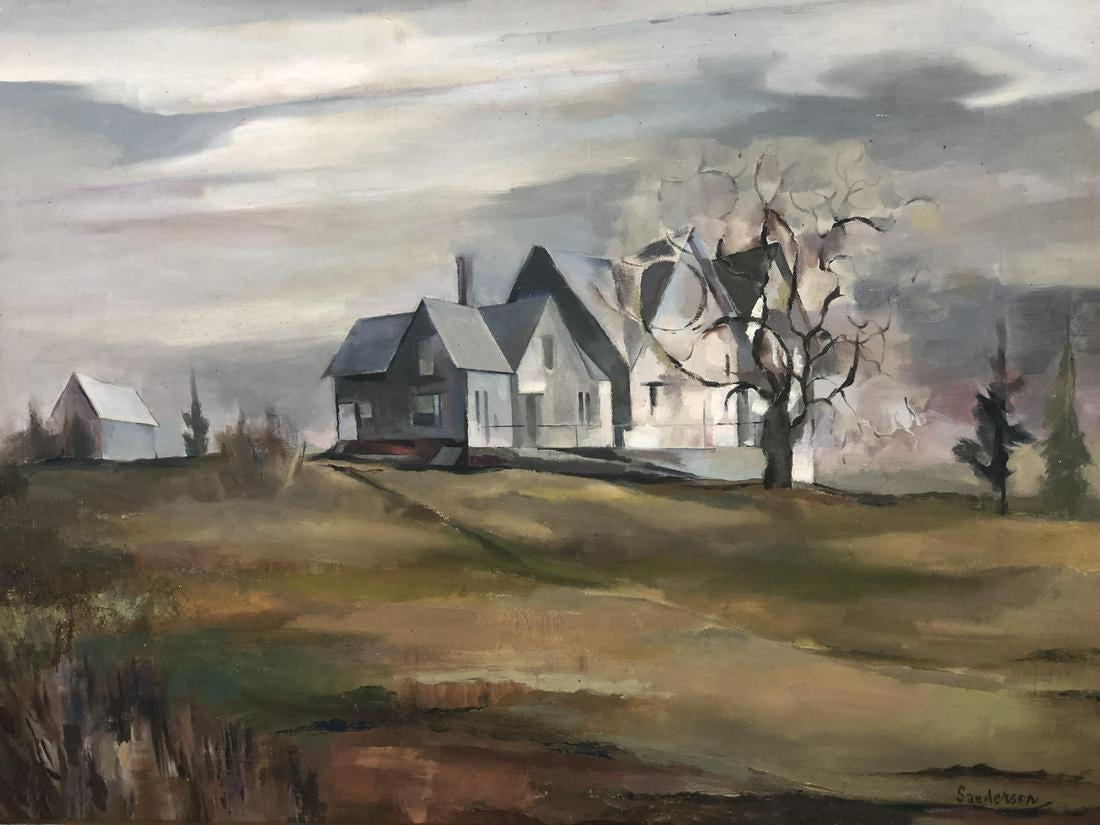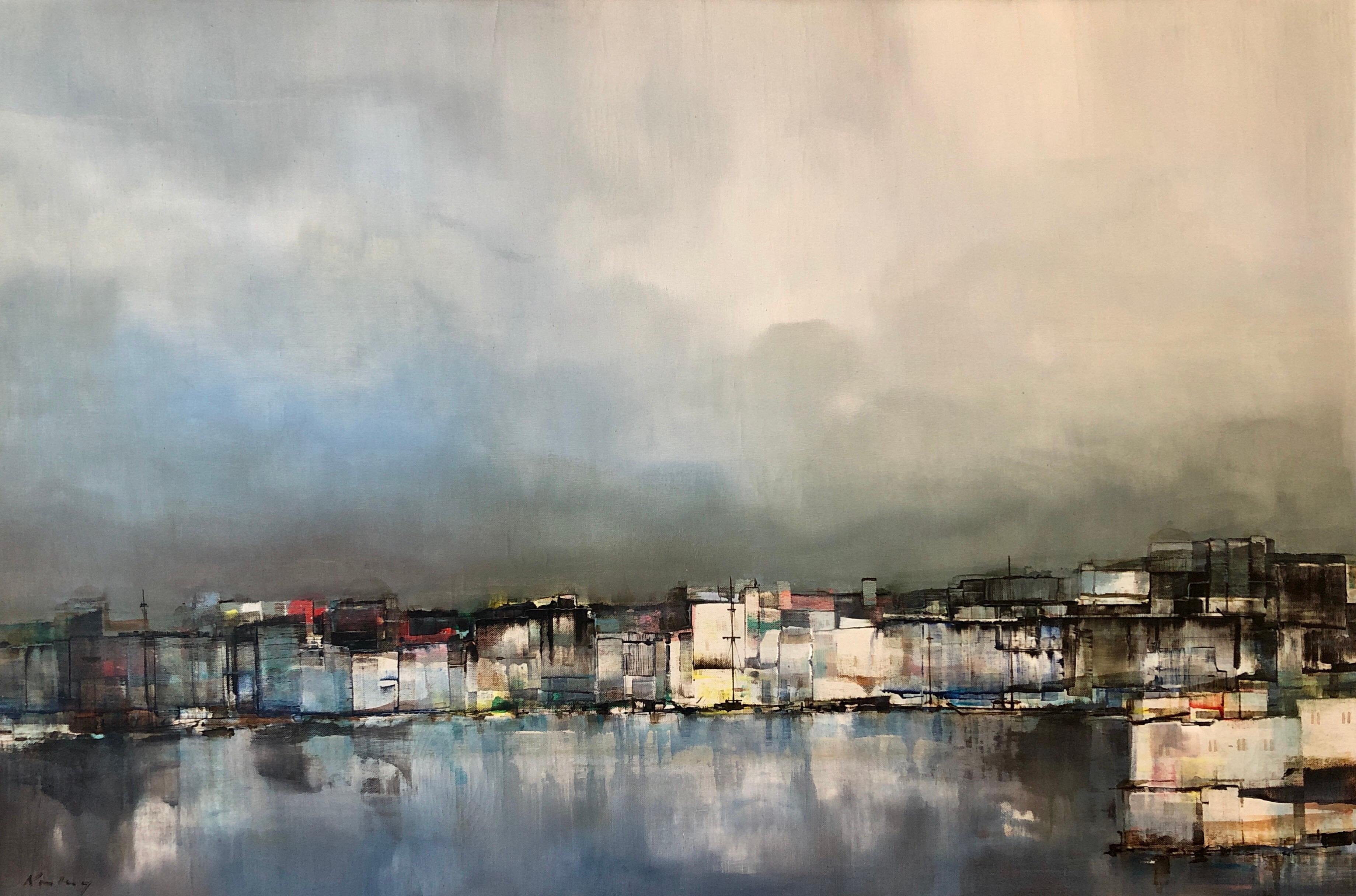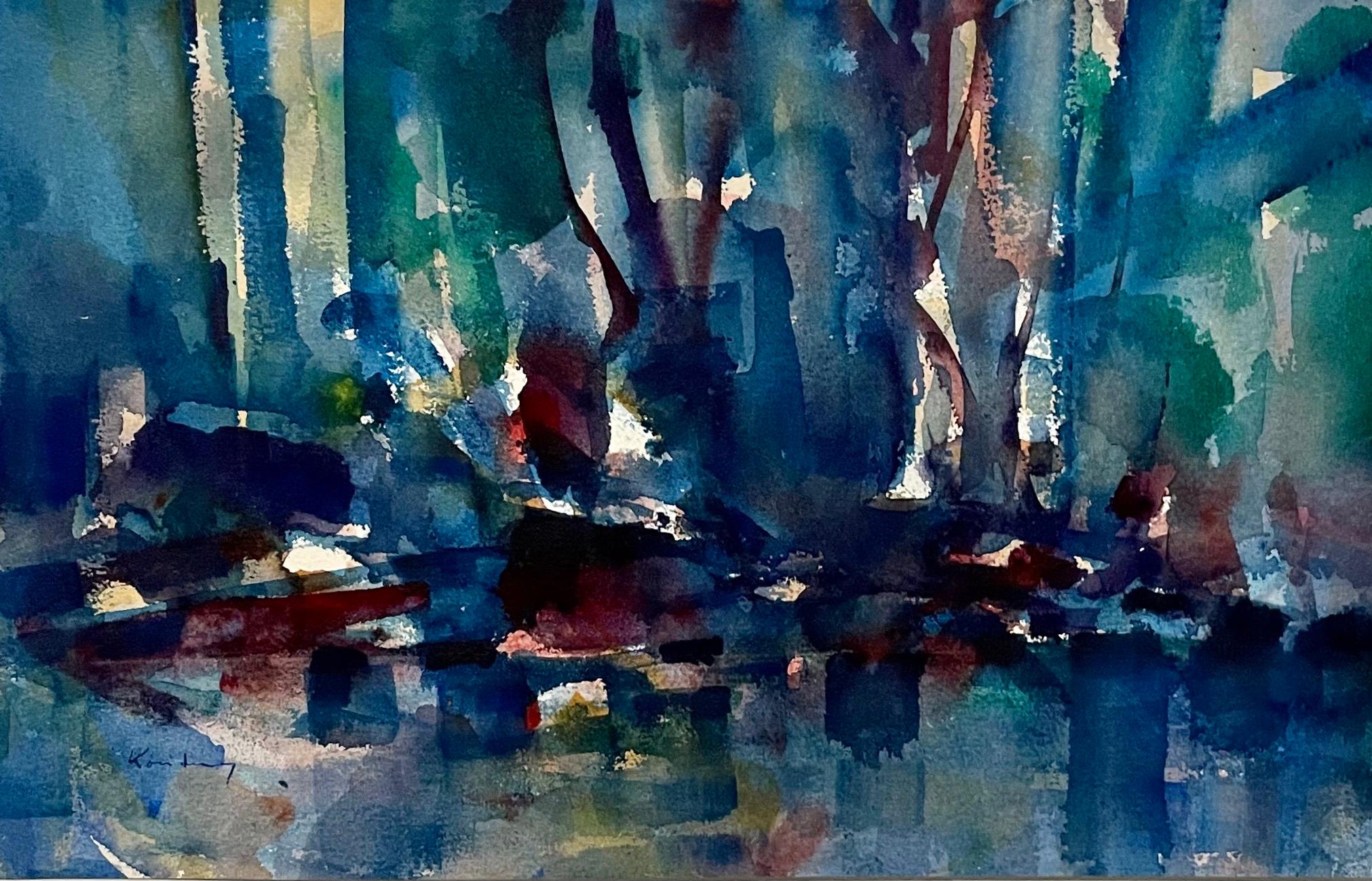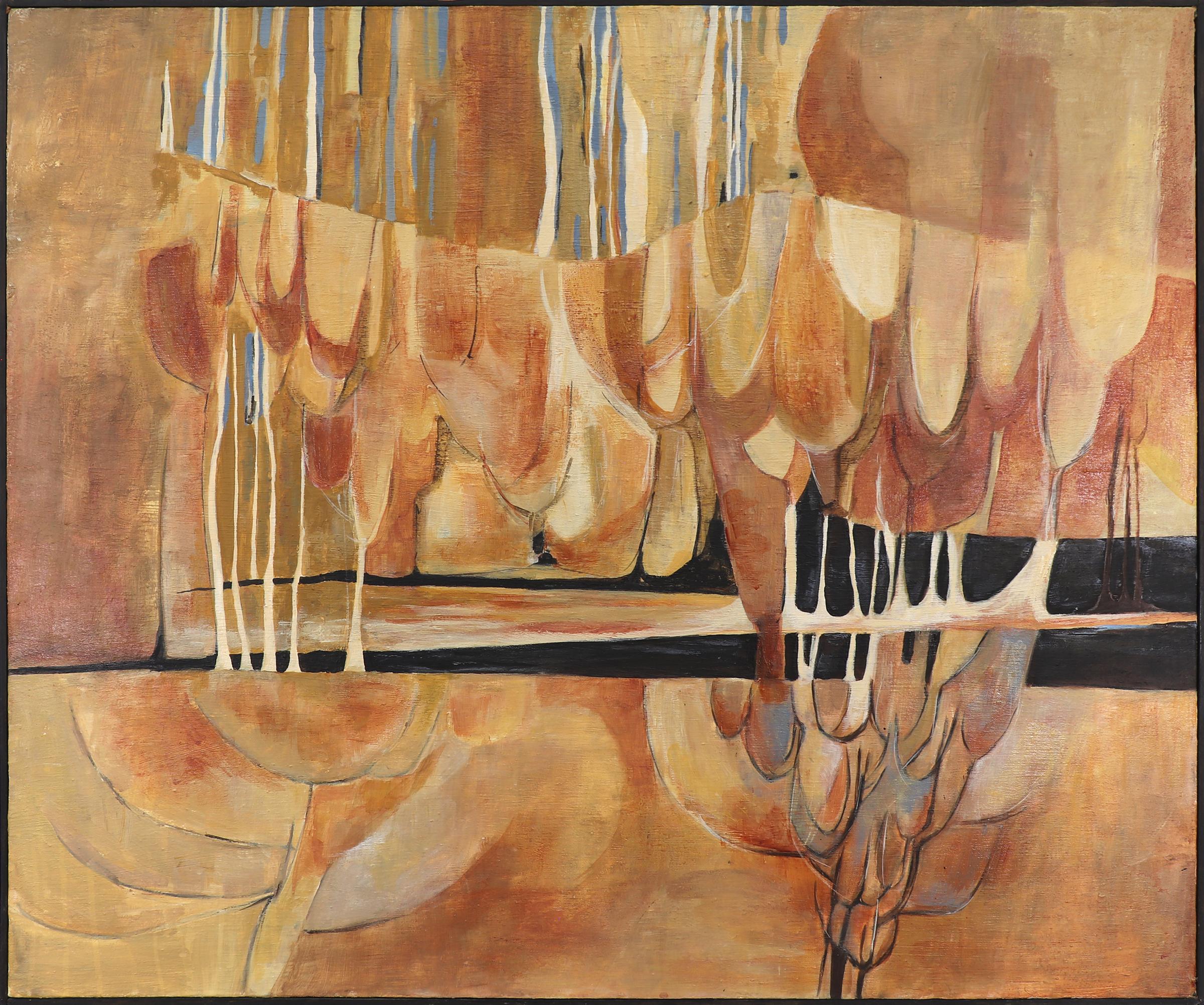Items Similar to Large 1960 California "Abstract Landscape" Jack Stuck Painting
Want more images or videos?
Request additional images or videos from the seller
1 of 16
Jack StuckLarge 1960 California "Abstract Landscape" Jack Stuck Painting1960
1960
About the Item
Jack Stuck (1925-1993)
"Abstract Landscape"
1960
Collage oil paint, charcoal, paper and canvas laid down on masonite
48"x46" natural wood frame 51" x 49"
Signed and dated lower left and reverse
Long Beach Museum of Art , Comara gallery labels affixed to back
- Creator:Jack Stuck (1925 - 1993, American)
- Creation Year:1960
- Dimensions:Height: 49 in (124.46 cm)Width: 51 in (129.54 cm)Depth: 2 in (5.08 cm)
- Medium:
- Movement & Style:
- Period:
- Condition:Very Good Condition - Minor wear consistent with age and history. Very small areas of paint loss.
- Gallery Location:Arp, TX
- Reference Number:1stDibs: LU1533210671302
About the Seller
5.0
Vetted Seller
These experienced sellers undergo a comprehensive evaluation by our team of in-house experts.
Established in 2015
1stDibs seller since 2021
70 sales on 1stDibs
Typical response time: 16 hours
Associations
Association of Women Art Dealers
- ShippingRetrieving quote...Ships From: Arp, TX
- Return PolicyA return for this item may be initiated within 2 days of delivery.
More From This SellerView All
- 1950s "Mound Street" Mid Century Figurative Painting American ModernistBy Donald StacyLocated in Arp, TXDonald Stacy "Mound Street" c. 1950s Gouache paint on paper 24" x 18'" unframed Unsigned Came from artist's estate For sale is a striking black and white painting titled "Mound Stre...Category
Mid-20th Century American Modern Abstract Paintings
MaterialsPaper, Gouache
- 1950s "Forest Through Window" MidCentury Abstract Gouache University of ParisBy Donald StacyLocated in Arp, TXDonald Stacy "Forest Through the Window" c.1950s Oil pastel and gouache paint on paper 14" x 17" unframed Unsigned Came from artist's estate Donald Stacy (1925-2011) New Jersey Studied: Newark School of Fine Art The Art Students League Pratt Graphic Arts Center University of Paris 1953-54 University of Aix-en-Provence 1954-55 Faculty: Art Department of the New School Museum of Modern Art School of Visual Arts Stacy Studio Workshop Exhibitions: Grand Central Moderns George Wittenborn The New School Print Exhibitions, Chicago University of Oklahoma Honolulu Museum Monclair Museum Wisconsin State College Louisiana Art...Category
Mid-20th Century American Modern Abstract Paintings
MaterialsPaper, Gouache, Oil Pastel
- 1950s "Two Trees" Mid Century Abstract Landscape Painting American ModernBy Donald StacyLocated in Arp, TXDonald Stacy "Two Trees" c.1950s Gouache on paper 24" x 18" unframed $950 Unsigned Came from artist's estate *Custom framing available for additional char...Category
Mid-20th Century American Modern Landscape Paintings
MaterialsPaper, Gouache
- 1950s "Purple Sky Landscape" Mid Century Abstract Landscape PaintingBy Donald StacyLocated in Arp, TXBearnice Fisher "Purple Sky Landscape" 1978 Gouache on paper 30" x 22.5" unframed Signed and dated lower right in pencil Bearnice Fisher lived and worked in NYCCategory
Mid-20th Century American Modern Landscape Paintings
MaterialsPaper, Gouache
- "The Cowboy" Mid Century Abstract Expressionist Female ArtistBy Sylvia RutkoffLocated in Arp, TXSylvia Rutkoff (1919-2011) Sr11-1 c.1960s “The Cowboy” Oil impasto on Masonite 42x36 period frame Signed on reverse in pencil Collection acquired from family estateCategory
Mid-20th Century Abstract Expressionist Landscape Paintings
MaterialsOil, Masonite
- "Crossed Arms" Mid Century Abstract Expressionist NYC Female ArtistBy Sylvia RutkoffLocated in Arp, TXSylvia Rutkoff (1919-2011) Sr5-1 c.1960s “Crossed Arms” Acrylic on Masonite 36x42 period frame Unsigned Collection acquired from family estateCategory
Mid-20th Century Abstract Expressionist Landscape Paintings
MaterialsMasonite, Oil
You May Also Like
- Waterfall (Woodstock, New York)By Grace Hill TurnbullLocated in Concord, MAGRACE HILL TURNBULL (1880-1976) Waterfall (Woodstock, New York), c. 1925 Oil on canvas 14 x 20 inches Unsigned PROVENANCE The Maryland Historical Society The work of pai...Category
1920s American Modern Landscape Paintings
MaterialsCanvas, Oil
- Amish Farmscape #3By Edmund LewandowskiLocated in Los Angeles, CAAmish Farmscape #3, 1984, oil on canvas, 40 x 30 inches, signed and dated lower right; signed, dated, and titled verso About the Painting Amish Farmscape #3 is part of a multi-painting series of barns completed in the early 1980s for an exhibition at New York’s prestigious Sid Deutsch Gallery. Lewandowski painted this work at an important point in his career. It was the first major project undertaken by Lewandowski after his retirement from serving as the Chairman of Winthrop University’s Art Department, the last academic position he held after teaching for nearly thirty years. Lewandowski had been inspired to work on the series by a visit to Lancaster County, Pennsylvania. Like his friend and mentor, Charles Sheeler, Lewandowski had always been fascinated by vernacular architecture and the Amish barns of Pennsylvania brought back memories of rural scenes Lewandowski had painted in the Midwest much earlier in his career. Amish Farmscape #3 is a strong example of Lewandowski’s late precisionist work. The complexity of the composition and Lewandowski’s technical acumen are on full display. Being relieved of the burdens of teaching and administering a university art department likely allowed Lewandowski greater freedom and most importantly more time to complete the Amish Farmscape series. Although Lewandowski’s brand of precisionism changed throughout the years, he never deviated from the core tenets of the Immaculate School artists. In this work, we see simplified and flattened forms, the use of ray-lines to define light and space, the elimination of extraneous details, a polished almost machine-like finish, and the complete lack of visible brushstrokes, all hallmarks of the precisionist painters. Lewandowski was the last of the 20th century precisionists and in Amish Farmscape #3, we see just how successfully he continued to work in this style until his death in 1998. About the Artist Edmund Lewandowski was among the best of the second-generation precisionist painters. He was born and raised in Milwaukee, Wisconsin and studied at the Layton School of Art with Garrett Sinclair. Lewandowski achieved early success when in 1936 two of his watercolors were shown at the Phillips Collection as part of a Federal Art Project exhibition. Then, in 1937, his work was first exhibited at Edith Halpert’s Downtown Gallery which represented Lewandowski into the 1950s. Under Halpert’s guidance, Lewandowski continued to explore watercolor as his main medium during the 1930s and 1940s, since the gallery already represented Charles Sheeler, who worked primarily in oils. Sheeler became Lewandowski’s major influence as the primary leader of the ill-defined, but very recognizable Immaculate School artists, which included other Downtown Gallery painters, Niles Spencer, George Ault, and Ralston Crawford, as well as Charles Demuth and Preston Dickinson, both of whom died at a young age and had been represented by the Charles Daniel Gallery. Sheeler is credited with giving Lewandowski technical advice on how to make his paintings more precise and tightly rendered and by all accounts, Sheeler was a fan of Lewandowski’s work. Through the Downtown Gallery, Lewandowski’s paintings were accepted into major national and international exhibitions and purchased by significant museums and collectors. Franklin and Eleanor Roosevelt and Nelson Rockefeller acquired works by Lewandowski. He was included in the Museum of Modern Art’s important 1943 exhibition, American Realists and Magic Realists as well as juried exhibitions at the Whitney Museum of American Art, the Pennsylvania Academy of Fine Arts, and the Art Institute of Chicago. Lewandowski also completed commissions for magazines during the 1940s and 1950s, including several covers for Fortune. Throughout his career, Lewandowski explored urban and rural architecture, industry, machinery, and nautical themes. Looking back on his career, Lewandowski wrote, “My overwhelming desire as an artist through the years has been to record the beauty of man-made objects and energy of American industry on canvas. For as far back as I can recall, the cityscapes, farms and depictions of industrial power and technological efficiency has had a great attraction for me. I try to treat these observations with personal honesty and distill these impressions to a visual order.” Lewandowski is credited with extending precisionism to the Midwest and successfully continuing the style into the 1990s, three decades after Sheeler’s death and six decades after Demuth’s passing. Late in his career, Lewandowski enjoyed a resurgence of popularity as he was represented during the 1980s by New York’s Sid Deutsch and Allison Galleries...Category
Mid-20th Century American Modern Landscape Paintings
MaterialsCanvas, Oil
- "Colorado Landscape, " Western Precisionist Regionalism American Scene PaintingBy William SandersonLocated in New York, NYReminiscent of an Edward Hopper or Andrew Wyeth scene, or even Charles Demuth with its cubist elements. William Sanderson (1905 - 1990) Colorado Landscape Oil on canvas 23 1/2 x 31 1/2 inches Signed lower right: Sanderson Born in Dubbeln, near Riga, Latvia in 1905, his personal journey from Czarist Russia, to New York City, and finally to Colorado, is one of remarkable courage and perseverance. Sanderson exhibited in numerous solo and group exhibitions throughout Colorado and the West between 1945 and 1985, and he was voted one of Colorado's influential artists of the 20th Century. Sanderson's paintings are represented in many museums and are sought after by collectors who appreciate his composition and precise use of color. The year 2005 marked the Centennial of Sanderson's birth, and he is now recognized as a major contributor to the development of modern art in Colorado. As a student at the National Academy of Design in 1927, Sanderson exemplifies an individual dedicated to creativity and the life-long passion for art. Known primarily as a Colorado artist, Sanderson first developed his skills as a graphic illustrator in New York City, and his work has appeared in numerous magazines, including New Yorker and New Masses. Notable book illustrations include The Jumping Off Place - 1929, by Marion Hurd McNeely, Jews Without Money - 1930, by Michael Gold...Category
Mid-20th Century American Modern Landscape Paintings
MaterialsCanvas, Oil
- Modernist Colorado Oil Painting Abstract Cityscape Harbor Scene Pawel KontnyBy Pawel KontnyLocated in Surfside, FLUrban landscape of city harbor, marine scene, (North Africa?) bearing the influence of the earlier color-block compositions of Paul Klee. Modernist Cityscape 24" x 36" sight. oil on ...Category
20th Century American Modern Landscape Paintings
MaterialsCanvas, Oil
- Modernist Abstract Expressionist Watercolor Painting Bauhaus Weimar Pawel KontnyBy Pawel KontnyLocated in Surfside, FLAbstract watercolor composition bearing the influence of the earlier color-block compositions of Paul Klee. Pawel August Kontny, (Polish-German-American artist) He was born in Laurahuette, Poland, in 1923, the son of a wealthy pastry shop owner. In 1939 he began studying architecture in Breslau where he was introduced to the European masters and to the work of some of the German Expressionists, soon afterward banned as "degenerate artists" and removed from museums throughout Germany by the Nazi regime. His studies were interrupted by World War II. Drafted into the German army, traveling in many countries as a soldier, he sketched various landscapes but in 1945, he was captured and held as a prisoner of war in Italy. After the war, he studied at the Union of Nuremberg Architects to help design buildings to replace ones destroyed in the war. He recorded his impressions of the local population and the landscapes through his watercolors and drawings. Pawel Kontny thereafter moved to Nuremberg, Germany, becoming a member of the Union of Nuremberg Architects and helping to rebuild the city's historic center. He soon decided to concentrate on his professional art career. He married Irmgard Laurer, a dancer with the Nuremberg Opera. Pavel Kontny 's career as an artist was launched with his participation in an all German exhibition, held at the Dusseldorf Museum in 1952. He held one-man shows in Germany, Switzerland and the United States. During his trip to the United States in 1960, Kontny became instantly enamored with Colorado, and decided to relocate to Cherry Hills with his wife and two children. He quickly established himself in the local art community, being affiliated for a time with Denver Art Galleries and Saks Galleries. His subject matter became the Southwest. During this time he received the Prestigious Gold Medal of the Art Academy of Rome. His extensive travel provided material for the paintings he did using his hallmark marble dust technique. he also worked equally in pastel, watercolor, charcoal and pencil-and-ink. in a style which merged abstraction and realist styles, influenced by Abstract Expressionist painting and South Western American landscapes. In the early 1960s he was one of only a few European-born professional artists in the state, a select group that included Herbert Bayer (1900-1985), a member of the prewar Bauhaus in Weimar and Dessau, Germany, and Roland Detre (1903-2001), a Hungarian modernist painter. As a Denver, Colorado resident, Pavel Kontny exhibited at galleries and museums throughout the United States, Germany and Japan. There, he was inspired by frequent trips to Native American pueblos in the Southwest, as well as by the study of the Plains Indians of Montana and Wyoming. Over the years Kontny had a number of students and generously helped young artist by hosting exhibitions at his Cherry Hills home. For many years he generously donated his paintings to support charitable causes in Denver. Influences during his European years included German pastelist C.O. Muller, German Informel painter Karl Dahmen and Swiss artist, Hans Erni. In the early 1950s his painting style showed the influence of the Die Brücke (The Bridge), a group of German expressionist artists formed in Dresden in 1905 who had a major impact on the evolution of modern art in the twentieth century in Germany. By the middle of the decade his style incorporated more referential abstraction and total abstraction, resulting in part from his study of Hans Hartung, a German artist based in Paris who exhibited his gestural abstract work in Germany. The American moon landing in 1969 inspired Paul Kontny...Category
20th Century American Modern Landscape Paintings
MaterialsCanvas, Oil
- American Modernist Abstract Landscape Oil Painting of Trees, Yellow Orange BlueLocated in Denver, COMid 20th Century abstracted landscape pen and oil painting with trees by American Modernist Henriette "Yetti" Stolz, signed on the back of the painting. Portrays a modernist landscape of a forest with trees, painted in shades of gold, brown, orange, and blue. Presented in a vintage frame measuring 30 ¾ x 36 ¼ inches. Image measures 30 ¼ x 35 ¾ inches. Provenance: Estate of the Artist, Henriette "Yetti" Stolz Painting is in good condition - please contact us for a detailed condition report. About the Artist: Henriette “Yetti” Stolz was born in Serbia in 1935 ( and is still living ). Her family emigrated to Denver, Colorado, in the early 1950s after WWII and she attended East High School before studying art at Colorado College, in Colorado Springs in the mid to late 50s. While there studying she would have been exposed to modernist artists working both at the college ( ie. Mary Chenoweth...Category
Mid-20th Century American Modern Abstract Paintings
MaterialsCanvas, Ink, Oil
Recently Viewed
View AllMore Ways To Browse
California Abstract
Abstract California Art
California Abstract Paintings
Used Jack
Large Art California
Abstract Landscape Large
Gallery Label
Long Beach
California Beach Painting
California Modern Painting
Large Modern Abstract Painting
Large Abstract Landscape Paintings
1960 California
Large Modern Art Abstract Painting
Large Painting California
California Oil Abstract
Mid Century Abstract Large
Large Abstract Wood Art





